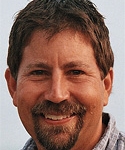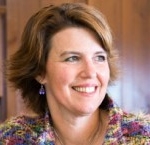Ben Kligler Leads Veterans Affairs Integrative Health Strategy
March 29, 2016
by John Weeks, Publisher/Editor of The Integrator Blog News and Reports
 Pioneering integrative health and medicine academic, researcher and clinician Benjamin Kligler, MD, MPH (pictured left) has been selected as the founding National Director to lead integrative health strategy at the Coordinating Center for Integrative Health of the U.S. Veterans Health Administration (VHA). In his new position, Kligler, a family medicine doctor, will help to significantly expand veterans' access to a range of integrative health services. His responsibilities will include creating training resources for VHA staff, and helping to set up and implement a process for evaluating the clinical outcomes related to integrative health services in the VHA population.
Pioneering integrative health and medicine academic, researcher and clinician Benjamin Kligler, MD, MPH (pictured left) has been selected as the founding National Director to lead integrative health strategy at the Coordinating Center for Integrative Health of the U.S. Veterans Health Administration (VHA). In his new position, Kligler, a family medicine doctor, will help to significantly expand veterans' access to a range of integrative health services. His responsibilities will include creating training resources for VHA staff, and helping to set up and implement a process for evaluating the clinical outcomes related to integrative health services in the VHA population.  The announcement was first made in a March 17, 2016 webinar on VHA activities from the Academic Consortium for Integrative Medicine and Health (ACIMH), for which Kligler is the immediate past chair. In this new position, Kligler, also an advisor to the Integrative Healthcare Symposium, will work closely with Tracy Gaudet, MD (pictured right), the director of the Office of Patient Centered Care and Cultural Transformation. By taking this position, Kligler will finish 16 years as a clinician-researcher at the Center for Health and Healing, one of the earliest and most visible of health system-based integrative centers. As the Center’s services gained respect in the sponsoring system, Kligler became vice chair of a new Department of Integrative Medicine at Mount Sinai Beth Israel. Kligler will continue in a part-time role directing the research program in integrative medicine at the Center for Health and Healing. Comment: This is exciting. Gaudet with whom Kligler will be working, was herself formerly the director of integrative medicine programs at the University of Arizona and later at Duke University. The integrative health and medicine community has handed off two of its very best to the nation’s veterans. While Gaudet’s work is better-known, Kligler’s work has been constant, in the trenches, smart, and strategic for nearly 20 years. Here is a sampling of his step-wise contributions that mark the arrival of integrative medicine in U.S. health care.
The announcement was first made in a March 17, 2016 webinar on VHA activities from the Academic Consortium for Integrative Medicine and Health (ACIMH), for which Kligler is the immediate past chair. In this new position, Kligler, also an advisor to the Integrative Healthcare Symposium, will work closely with Tracy Gaudet, MD (pictured right), the director of the Office of Patient Centered Care and Cultural Transformation. By taking this position, Kligler will finish 16 years as a clinician-researcher at the Center for Health and Healing, one of the earliest and most visible of health system-based integrative centers. As the Center’s services gained respect in the sponsoring system, Kligler became vice chair of a new Department of Integrative Medicine at Mount Sinai Beth Israel. Kligler will continue in a part-time role directing the research program in integrative medicine at the Center for Health and Healing. Comment: This is exciting. Gaudet with whom Kligler will be working, was herself formerly the director of integrative medicine programs at the University of Arizona and later at Duke University. The integrative health and medicine community has handed off two of its very best to the nation’s veterans. While Gaudet’s work is better-known, Kligler’s work has been constant, in the trenches, smart, and strategic for nearly 20 years. Here is a sampling of his step-wise contributions that mark the arrival of integrative medicine in U.S. health care. - In 1999, Kligler led an effort to create “curricular guidelines” in integrative medicine for the Society of Teachers of Family Medicine (STFM).
- In 2004, he was again lead author on the ACIMH-endorsed, Core Competencies for Integrative Medicine in Medical School Curricula, the publication of which was a watershed moment for that field.
- In 2004-2005, he served as an active participant on the interprofessional steering committee for the 12-profession National Education Dialogue to Advance Integrated Health Care: Creating Common Ground (NED).
- In 2007, Kligler was lead author on a publication on competency-based evaluation tools for integrative medicine in a family medicine residency.
- In 2012-2014, he was elected to chair of the ACIMH.
- In 2013, Kligler was asked by the influential Bravewell Collaborative of philanthropists to serve as co-lead for their legacy research BraveNet project.
- In 2014, he was selected to chair the steering committee for the Health Resources and Services Administration’s National Center for Integrative Health in Primary Care.
 In 2005, Kligler and I co-led a survey of all of the integrative centers and “CAM” academic centers to create baseline information on the extent of inter-institutional relationships. We reported the results in 2006 at the first ACIMH conference in Edmonton, where we are pictured together (left) with colleague David O’Bryon, the present chair of the Academic Collaborative for Integrative Health (ACIH). The ACIH is an organization led by chiropractors, naturopathic doctors, acupuncture professionals, and others for which Kligler serves as a member of the Council of Advisors. Kligler’s complex understanding of integrative health and medicine – from mindfulness and self-care to an interprofessional teamwork – has guided some of his most significant contributions. As I was reflecting on what he has meant to the movement, I recalled his account of a piece of work between the integrative medicine educators and “CAM” academics in 2005. The work instilled interprofessionalism in the Consortium’s self-definition. Here is Kligler: “A group of us [from the Consortium] had just completed an arduous consensus project to develop competencies in integrative medicine for medical students [noted above]. The article we proposed to publish was also the first formal presentation of the Consortium’s newly minted definition of integrative medicine, which included the phrase ‘use of all appropriate therapeutic approaches to achieve optimal health and healing.’ Very open-minded, we thought. But we had forgotten that these therapeutic approaches were developed and practiced by our colleagues in the CAM professions – and that leaving them out of the definition could be read as a mandate for MDs to go ahead and appropriate anything they found useful from the other healing arts and leave the practitioners of those arts behind.” Kligler then noted that some from the “CAM” group pushed back, “and not very gently.” He concluded with the following: “I remember a very painful session at the NED. I remember trying my hardest not to be defensive, and to hear what my colleagues were saying. It wasn’t easy. But we did it. So the definition reads ‘use of all appropriate therapeutic approaches healthcare professionals and disciplines to achieve optimal health and healing.’ [It was a] giant step for integrative healthcare.” So it is a giant step for integrative health and medicine that Kligler has decided to bring all the wisdom and experience suggested by this tremendous legacy into the VHA. Lucky for us and for the VHA.
In 2005, Kligler and I co-led a survey of all of the integrative centers and “CAM” academic centers to create baseline information on the extent of inter-institutional relationships. We reported the results in 2006 at the first ACIMH conference in Edmonton, where we are pictured together (left) with colleague David O’Bryon, the present chair of the Academic Collaborative for Integrative Health (ACIH). The ACIH is an organization led by chiropractors, naturopathic doctors, acupuncture professionals, and others for which Kligler serves as a member of the Council of Advisors. Kligler’s complex understanding of integrative health and medicine – from mindfulness and self-care to an interprofessional teamwork – has guided some of his most significant contributions. As I was reflecting on what he has meant to the movement, I recalled his account of a piece of work between the integrative medicine educators and “CAM” academics in 2005. The work instilled interprofessionalism in the Consortium’s self-definition. Here is Kligler: “A group of us [from the Consortium] had just completed an arduous consensus project to develop competencies in integrative medicine for medical students [noted above]. The article we proposed to publish was also the first formal presentation of the Consortium’s newly minted definition of integrative medicine, which included the phrase ‘use of all appropriate therapeutic approaches to achieve optimal health and healing.’ Very open-minded, we thought. But we had forgotten that these therapeutic approaches were developed and practiced by our colleagues in the CAM professions – and that leaving them out of the definition could be read as a mandate for MDs to go ahead and appropriate anything they found useful from the other healing arts and leave the practitioners of those arts behind.” Kligler then noted that some from the “CAM” group pushed back, “and not very gently.” He concluded with the following: “I remember a very painful session at the NED. I remember trying my hardest not to be defensive, and to hear what my colleagues were saying. It wasn’t easy. But we did it. So the definition reads ‘use of all appropriate therapeutic approaches healthcare professionals and disciplines to achieve optimal health and healing.’ [It was a] giant step for integrative healthcare.” So it is a giant step for integrative health and medicine that Kligler has decided to bring all the wisdom and experience suggested by this tremendous legacy into the VHA. Lucky for us and for the VHA.



















SHARE